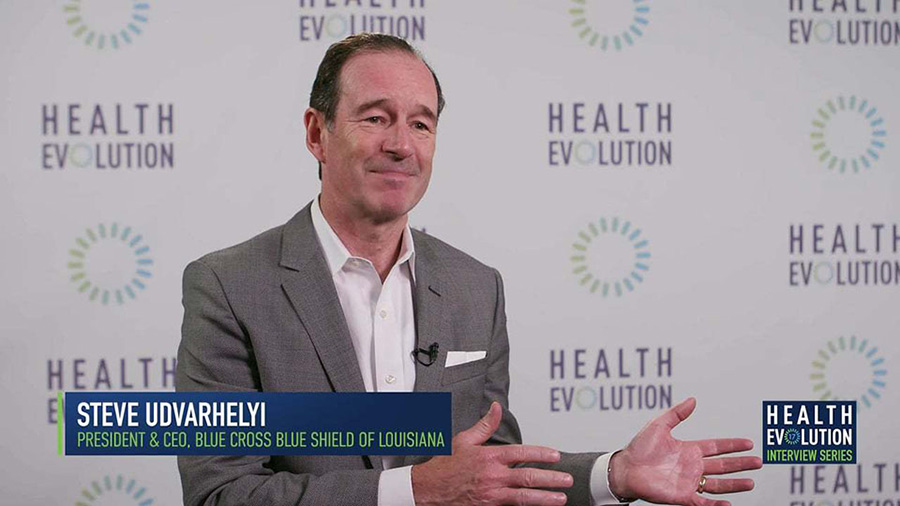As tempting as it may be to think that the industry is on the verge of rapid, substantial changes that will improve how care is delivered and paid for, in reality health care is still grappling with some of the challenges CEOs were facing as far back as 25 years ago.
Three of the hardest to solve are access, cost and quality, according to Steve Udvarhelyi, MD, President and CEO of Blue Cross and Blue Shield of Louisiana.
Health Evolution Editor-in-Chief Tom Sullivan spoke with Udvarhelyi about his skepticism toward the widespread consensus that the industry is on the cusp of rapid change, where AI, analytics and augmented reality are already being used, and his perspective on payer-provider convergence in the transition to value-based care.
Health Evolution: Let’s start with a reality check. There’s something of a consensus that health care as an industry is on the verge of a decade of change and innovation. What’s your perspective?
Udvarhelyi: Having been now in this industry for a while, I would agree there’s a lot of change but would also say there are a lot of things that haven’t changed. The promise of material change and disruption, we’ve gone through several cycles of that without a lot of change. Not to be a cynic, but we tend to overestimate the amount of change.
Health Evolution: Given that perspective, what are the changes you’d like to see happening more quickly?
Udvarhelyi: I’m hoping that the delivery of health care is really on the cusp of changing in fundamental ways that will enhance the role of clinicians, make better use of analytics for taking care of patients, make care more convenient, engage patients in a better way. That process requires the delivery system to change and adapt and there’s a complex array of stakeholders in health care. If the delivery system begins to change, it pulls everyone else along with it. You have payers on one side, and clinical delivery on the other and almost everyone interfaces with those two. Whether it’s pharma or medical devices, everything comes via the delivery system.
Health Evolution: Ambitious undertakings, and hard ones at that, but many people would agree with those as the right direction. What are the changes you see already underway, even incrementally?
Udvarhelyi: It’s beginning to happen but it will take some time to fully play out. I see changes taking place now that I didn’t see before. Certainly, the ability to use technology to deliver services via telehealth is beginning to take hold in a variety of places. We’re starting to see the application of augmented reality and AI in healthcare – such as pattern recognition. If you’re trying to look at a dermatology scan for melanoma, AI can do a really good job at that, and retinal screening for diabetic retinopathy, in some cases doing it with less error than clinicians. So that’s an interesting change.
Health Evolution: Another area where change is happening slowly is value-based care …
Udvarhelyi: Value-based payments are necessary but not sufficient to change the delivery system. Oak Street Health – that model looks very, very different. One Medical is another example. We’re beginning to get some traction and that puts pressure on the delivery system.
Health Evolution: We’re also starting to see payer and provider alignment improve, some technologies are making iterative progress and new care models are emerging, if slowly. How do you envision those shaping the industry in the next 3-5 years?
Udvarhelyi: That’s where things stay the same. 25 years ago, the top 3 issues were access, cost and quality. That hasn’t changed.
Health Evolution: Interesting point that access, cost and quality have been problematic for more than two decades and are still predominant today. Will CEOs still be grappling with those 10 years from now? What about 25 years into the future?
Udvarhelyi: We’ve made some progress. This is not a political statement about the Affordable Care Act, but the uninsured rate has gone down. Cost is going to be a durable problem that we won’t solve in the next 25 years. But we’ll make more progress than we made in the last 25 years. There’s a part of access that’s not just insurance but the convenience of care. There are health workforce shortages in the US urban central areas, rural America, so I don’t think we’ve solved for how we’re going to create the necessary workforces of the future. If we’re going to solve access, we have to do that. Even though we’ve expanded coverage, 40-50 percent of people with insurance avoid going to the doctor because of the cost of services. The emergence of these multi-million dollar treatments out of biotech and pharma are also putting pressure on the traditional financing of healthcare and so in some ways the cost issue is getting more exacerbated, not better.
Health Evolution: That’s a big part of the cost issue and you said we won’t solve it in 25 years. Is there any end in sight for multi-million dollar treatments?
Udvarhelyi: The larger question is what is the real price of those if they’re curative? The fact that they vary internationally is part of the other issue that we’re dealing with. We do not have a solution yet. A lot of what we talk about now, digital health, consumer centric care, value-based care, none of that’s new. What’s exciting is that were actually starting to do it and not just talk about it. Some of the bigger systems are starting to do it, forces from outside are doing it. There’s a lot capital behind it now.
Health Evolution: With that capital going into the shift to value, patient-centric care, and digital health, would you say we are at a critical juncture or just moving closer to it?
Udvarhelyi: Payers are unique in touching all aspects of the industry. The changes that I’ve seen since coming to Louisiana in early 2016 as a big advocate for investing in data and analytics – those are beginning to pay off and are the right direction to go. That’s not an outlier. Another change is getting more engaged in Medicare and Medicaid and if you’re going to try to serve the communities you have to be not just in the commercial space but in the government space as well. The third change is convergence between payers and providers. Payers are getting directly involved, Optum buying physician practices, Florida Blue setting up clinics.
Health Evolution: How do you see that payer-provider convergence changing the industry?
Udvarhelyi: When organizations extend beyond traditional capabilities, you have to make sure you have the management skills to be in the new space. It puts pressure on both payers and providers to think about the integration of payment and care delivery change and that’s one of the reasons we might start to see some fundamental change.
[Editor’s note: Udvarhelyi will serve as emcee at the upcoming invite-only Health Evolution Summit Executive Briefing: Artificial Intelligence and Machine Learning, April 1, 2020 in Laguna Niguel, California. Apply to attend.]









